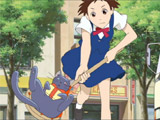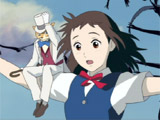

Quick Links:
The Cat Returns
The movies of Studio Ghibli bring to life many different stories and characters of all kinds, yet there are a few things about them that are rarely different. You can always count on a Ghibli movie to include breathtaking, colorful backgrounds. More often than not, you can identify a Ghibli character design in a lineup, even if you don't know who it is. And while there might be elements of the supernatural in Ghibli movies, they feel surprisingly down to Earth. The Cat Returns retains one of these conventions and blows the other two away. With fresh new character designs and a storybook fantasy feel, the film is likely to surprise some people.
The Cat Returns begins by showing us a little bit about main character Haru Yoshioka's normal life as a friendly yet rarely punctual teen. The story quickly becomes less and less normal after she saves a cat from being run over by a large truck. The cat stands up on his hind legs and speaks to her, expressing his gratitude for what she did - then he bows and takes off while she's still not believing her eyes. Later on that evening, a strange procession of cats moves up her street and stops in front of her house. The visitor sits on the throne of the "Kingdom of Cats", and informs Haru that she will be rewarded for her kindness with boundless good fortune. As she is about to find out, the cats' idea of good fortune and Haru's don't match.
The title of the film in Japan is Neko no Ongaeshi, which literally means "Cat's Requital" (or alternatively, "The cat returns the favor"). The official English title, The Cat Returns, is suggestive of a homecoming instead of a requital, and thus seems a bit off base. Ironically enough, there are two characters in the film who are appearing for a second time, and they are both cats. The ornery fat cat of many names from Whisper of the Heart makes an appearance in this film, and most call him Muta. Also appearing from Whisper of the Heart is the Baron Humbert von Jikkengen, a figurine-turned-storybook-hero.
A good amount of the film takes place in the fairytale inspired "Kingdom of Cats." (This fact alone makes the film rather unique in the face of most other studio Ghibli films, which are at least loosely based in reality.) Haru's challenge is to stay true to herself in this strange land, or she will lose a major part of herself. It's difficult to appreciate her challenge due to the sheer cuteness of the whole spectacle, but in a way that is an element of fairytales as well. In addition to the cuteness, the story is also a great deal of fun. Haru has the help of Muta, the Baron, and a gargoyle-turned-crow named Toto during most of the film. The Baron is suave and well-spoken, and the other two are always quarreling despite being good friends. The dynamic of this group of characters and Haru together is responsible for most of the enjoyment that can be had from this film, but the other characters (cat and human) contribute their fair share of amusing behaviors as well. All in all, the story is one that can be appreciated. It has an appropriate ratio of humor to serious plot, doesn't go off on any wild tangents, and has memorable characters. There is even real growth on the part of Haru, despite the carefree and light-hearted nature of the movie. The film has a strong finish, thanks to this.
The Cat Returns is also unique in that the designs for the human characters are rather unlike what you'll typically see in a Ghibli movie. They have a certain freshness that's difficult to describe, and it gives the film an individuality that few of the others have. The eye colors really stand out at times, and the characters' motions (cat and human alike) are as lifelike as ever. The animation for this feature is of normal quality, for a Ghibli movie. Motions are fluid and graceful, and the backgrounds are absolutely gorgeous - with vibrant colors and fine details galore.
The music for The Cat Returns is light-footed and chipper, in general. It's a pleasure to listen to, and it moves the film along at a good pace. The ending song (Kaze ni Naru, meaning "I Become the Wind") is somewhat of a folk tune, but it has a fresh feel as well as a nostalgic one. It's catchy, and the kind of song that might get stuck in your head.
Accompanying the DVD release of the film in Japan is the second episode of the "Ghiblies" short films, which feature the workers of an animation studio named Ghibli (in a fictional sense, of course). This installment is a humorous account of a lunch outing to the nearby extra-spicy curry place, and of childhood memories and a few other things. At about 25 minutes, it's not as short as your typical short film, but is certainly an enjoyable extra. It also shows in a way how Ghibli films are more than just pretty colors - since the characters and overall style are about as simplistic as a South Park episode, yet the magic is still there.
The Cat Returns is easy to recommend. The plot is consistent and complete, the characters are lovable and developed as needed (instead of out of a sense of obligation), and the eye candy is as potent as ever. Fans of the Disney animated movies stand to get a lot of enjoyment out of this film due to its fairytale setting, and the Ghibli and Disney brands of magic suddenly seem a bit closer than before. This movie shows that for great family entertainment, you still can't go wrong with Studio Ghibli.
Distributor: Disney (Japan DVD Release) Creator: Hiroyuki Morita / Studio Ghibli Released: 2002
Plot: A Character Design: A Animation Quality: A+ Music: A Overall: A



